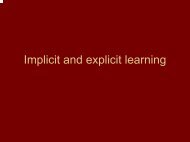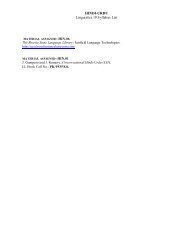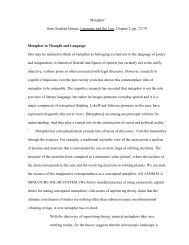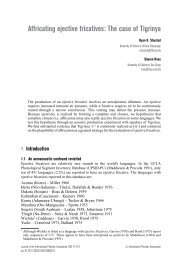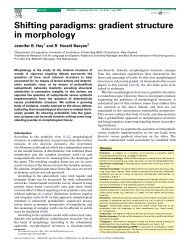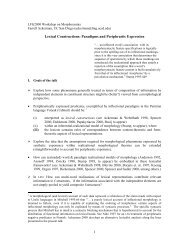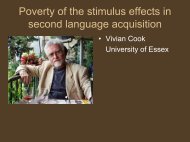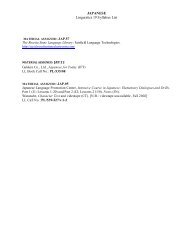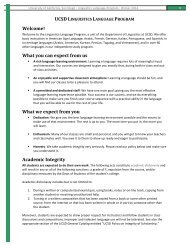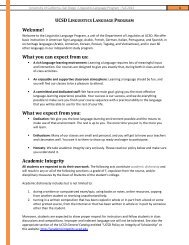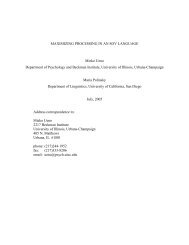The morphological structure of the Moro verb Sharon Rose
The morphological structure of the Moro verb Sharon Rose
The morphological structure of the Moro verb Sharon Rose
You also want an ePaper? Increase the reach of your titles
YUMPU automatically turns print PDFs into web optimized ePapers that Google loves.
<strong>The</strong> <strong>morphological</strong> <strong>structure</strong> <strong>of</strong> <strong>the</strong> <strong>Moro</strong> <strong>verb</strong><br />
to have H tone and to locate it preferentially at <strong>the</strong> left edge, Jenks & <strong>Rose</strong><br />
(2011) argue that <strong>the</strong> H tone is inserted, as in certain Bantu languages with<br />
predictable tone systems (Odden 1989). <strong>The</strong> lexical dimension <strong>of</strong> <strong>the</strong> system<br />
concerns not <strong>the</strong> appearance <strong>of</strong> H tone, but its ability ei<strong>the</strong>r to extend, or to<br />
appear on a root-initial vowel.<br />
In addition to <strong>the</strong> proximal imperfective, a number <strong>of</strong> o<strong>the</strong>r <strong>verb</strong> forms also<br />
employ default tone. <strong>The</strong>se all appear in subordinate <strong>verb</strong> forms, which are<br />
marked by different prefixes than <strong>the</strong> imperfective and perfective forms<br />
discussed above. This sample shows <strong>the</strong> roots ʧombəð (HL pattern) ‘tickle’<br />
and ilið (LH pattern) ‘buy’ in 3SG. Unlike <strong>the</strong> proximal imperfective, <strong>the</strong>re is<br />
no clause marker or class marker. Instead, an invariant subject marker<br />
appears (3SG is áŋ-/ʌ́ŋ- or ə́ŋə́-) which may be preceded by a complementizer<br />
nə́-, nə- or t ̪ə́-. <strong>The</strong> proximal/distal distinctions in <strong>the</strong>se <strong>verb</strong> forms is <strong>the</strong><br />
same as with <strong>the</strong> main imperfectives and imperatives, but <strong>the</strong> distinction is<br />
conveyed only through <strong>the</strong> final suffix, not tone patterns.<br />
(18) ‘tickle’ ‘buy’<br />
subordinate 1 proximal (n)-áŋ- ↓ ʧómbəð-e (n)-ʌ́ŋ-ilíð-i<br />
subordinate 1 distal (n)-áŋ- ↓ ʧómbəð-a (n)-ʌ́ŋ-ilíð-ʌ<br />
subordinate 2 proximal (n)-áŋ- ↓ ʧómbəð-a (n)-ʌ́ŋ-ilíð-ʌ<br />
subordinate 2 distal (n)-áŋ- ↓ ʧómbəð-ó (n)-ʌ́ŋ-ilí ↓ ð-ú<br />
consecutive imperfective t̪-áŋ- ↓ ʧómbəð-ó t̪-ʌ́ŋ-ilí ↓ ð-ú<br />
consecutive proximal perfective n-ə́ŋə́- ↓ ʧómbəð-e n-ə́ŋ-ilíð-i<br />
consecutive distal perfective n-ə́ŋə́- ↓ ʧómbəð-a n-ə́ŋ-ilíð-ʌ<br />
negative g-anːá áŋ- ↓ ʧómbəð-a g-anːá ʌ́ŋ-ilíð-ʌ<br />
negative imperative ánːá á- ↓ ʧómbəð-a ánːá í ↓ líð-ʌ<br />
Subordinate 1 <strong>verb</strong>s are used in future constructions following <strong>the</strong> <strong>verb</strong>s ið<br />
‘make, do’ or vəl/vəd ‘go’, and as complements <strong>of</strong> certain <strong>verb</strong>s such as boaɲ<br />
‘want’. <strong>The</strong>y are marked with -e in <strong>the</strong> proximal, but with -a if a distal form<br />
is possible:<br />
(19) óráŋ g-a-və́l-á áŋ- ↓ áp-e ŋeɾá<br />
man SM.CL-RTC-go-IPFV 3SG.SM-take-SUB1 child<br />
<strong>the</strong> man is going to hold <strong>the</strong> child<br />
Subordinate 2 <strong>verb</strong>s occur as complements <strong>of</strong> <strong>the</strong> <strong>verb</strong>s indəʧin ‘try’ and neð<br />
‘refuse’. <strong>The</strong> distal form ends in ó, but o<strong>the</strong>rwise has <strong>the</strong> same tone pattern. 6<br />
6 <strong>The</strong> exception to default tone in <strong>the</strong> subordinate forms are <strong>the</strong> 1PL.EXCL and<br />
<strong>the</strong> 3PL, which always have low toned roots.<br />
9



